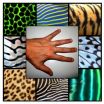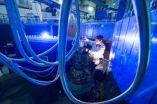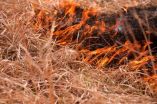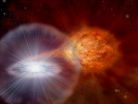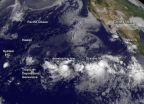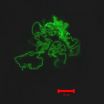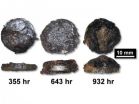(Press-News.org) Alan Turing, the British mathematician (1912-1954), is famous for a number of breakthroughs, which altered the course of the 20th century. In 1936 he published a paper, which laid the foundation of computer science, providing the first formal concept of a computer algorithm. He next played a pivotal role in the Second World War, designing the machines which cracked the German military codes, enabling the Allies to defeat the Nazis in several crucial battles. And in the late 1940's he turned his attention to artificial intelligence and proposed a challenge, now called the Turing test, which is still important to the field today.
His contribution to mathematical biology is less famous, but was no less profound. He published just one paper (1952), but it triggered a whole new field of mathematical enquiry into pattern formation. He discovered that a system with just 2 molecules could, at least in theory, create spotty or stripy patterns if they diffused and chemically interacted in just the right way.
His mathematical equations showed that starting from uniform condition (ie. a homogeneous distribution – no pattern) they could spontaneously self-organise their concentrations into a repetitive spatial pattern. This theory has come to be accepted as an explanation of fairly simple patterns such as zebra stripes and even the ridges on sand dunes, but in embryology it has been resisted for decades as an explanation of how structures such as fingers are formed.
Now a group of researchers from the Multicellular Systems Biology lab at the CRG, led by ICREA Research Professor James Sharpe, has provided the long sought-for data which confirms that the fingers and toes are patterned by a Turing mechanism. "It complements their recent paper (Science 338:1476, 2012), which provided evidence that Hox genes and FGF signaling modulated a hypothetical Turing system. However, at that point the Turing molecules themselves were still not identified, and so this remained as the critical unsolved piece of the puzzle. The new study completes the picture, by revealing which signaling molecules act as the Turing system" says James Sharpe, co-author of the study.
The approach taken was that of systems biology – combining experimental work with computational modelling. In this way, the two equal-first authors of the paper were able to iterate between the empirical and the theoretical: the lab-work of Jelena Raspopovic providing experimental data for the model, and the computer simulations of Luciano Marcon making predictions to be tested back in the lab.
By screening for the expression of many different genes, they found that two signalling pathways stood out as having the required activity patterns: BMPs and WNTs. They gradually constructed the minimal possible mathematical model compatible with all the data, and found that the two signalling pathways were linked through a non-diffusible molecule – the transcription factor Sox9. Finally, they were able to make computational predictions about the effects of inhibiting these 2 pathways – either individually, or in combination – which predicted how the pattern of fingers should change. Strikingly, when the same experiments were done on small pieces of limb bud tissue cultured in a petri dish the same alterations in embryonic finger pattern were observed, confirming the computational prediction.
This result answers a long-standing question in the field, but it has consequences that go beyond the development of fingers. It addresses a more general debate about how the millions of cells in our bodies are able to dynamically arrange themselves into the correct 3D structures, for example in our kidneys, hearts and other organs. It challenges the dominance of an important traditional idea called positional information, proposed by Lewis Wolpert which states that cells know what to do because they all receive information about their "coordinates" in space (a bit like longitude and latitude on a world map). Today's publication highlights instead that local self-organising mechanisms may be much more important in organogenesis than previously thought.
Arriving at the correct understanding of multicellular organization is essential if we are to develop effective strategies for regenerative medicine, and one day to possibly engineer replacement tissues for various organs. In the shorter term, these results also explain why polydactyly – the development of extra fingers or toes – is such a common birth defect in humans: Turing systems are mathematically known to have slightly lower precision in regulating the number of "stripes" than alternative models.
At first glance, the question of how an embryo develops seems unrelated to the problems of computing and algorithms with which Turing is more commonly associated. In reality however, they were both expressions of his interest in how complex and clever biological "machines" arise in nature. In a sense, he sought the algorithms by which life builds itself. It is fitting that this study, which has confirmed Turing's 62 year-old theory on embryology, required the development of a serious computer model. It brings together two of his major life achievements into one satisfying result.
INFORMATION:
Article J. Raspopovic; L. Marcon; L. Russo; J. Sharpe. Digit patterning is controlled by a Bmp-Sox9-Wnt Turing network modulated by morphogen gradients. Science, 2014. DOI: 10.1126/science.1252960
A mathematical theory proposed by Alan Turing in 1952 can explain the formation of fingers
CRG researchers confirm that a mathematical theory first proposed by Alan Turing in 1952 can explain the formation of fingers
2014-07-31
ELSE PRESS RELEASES FROM THIS DATE:
Nanostructured metal-oxide catalyst efficiently converts CO2 to methanol
2014-07-31
UPTON, NY-Scientists at the U.S. Department of Energy's (DOE) Brookhaven National Laboratory have discovered a new catalytic system for converting carbon dioxide (CO2) to methanol-a key commodity used to create a wide range of industrial chemicals and fuels. With significantly higher activity than other catalysts now in use, the new system could make it easier to get normally unreactive CO2 to participate in these reactions.
"Developing an effective catalyst for synthesizing methanol from CO2 could greatly expand the use of this abundant gas as an economical feedstock," ...
Refocusing research into high-temperature superconductors
2014-07-31
Below a specific transition temperature superconductors transmit electrical current nearly loss-free. For the best of the so-called high-temperature superconductors, this temperature lies around -180 °C – a temperature that can be achieved by cooling with liquid nitrogen.
The location of atomic nuclei and binding electrons in a material is determined by its crystal structure. However, electrons additionally have an electromagnetic angular momentum, referred to as spin. When many spins become coupled in a material, electromagnetic disturbances with a preferential orientation ...
Study finds benefits to burning Flint Hills prairie in fall and winter
2014-07-31
MANHATTAN — Kansas State University researchers have completed a 20-year study that looks at the consequences of burning Flint Hills prairie at different times of the year. It finds that burning outside of the current late spring time frame has no measurable negative consequences for the prairie and, in fact, may have multiple benefits.
The study was conducted by Gene Towne, research associate and the Konza Prairie Biological Station fire chief, and Joseph Craine, research assistant professor, both in the Division of Biology. They recently published the study, "Ecological ...
Fermi satellite detects gamma-rays from exploding novae
2014-07-31
TEMPE, Ariz. - The Universe is home to a variety of exotic objects and beautiful phenomena, some of which can generate almost inconceivable amounts of energy. ASU Regents' Professor Sumner Starrfield is part of a team that used the Large Area Telescope (LAT) onboard NASA's Fermi Gamma-ray Space Telescope satellite to discover very high energy gamma rays (the most energetic form of light) being emitted by an exploding star. The surprising discovery dispels the long-held idea that classical nova explosions are not powerful enough to produce such high-energy radiation.
In ...
NASA sees Genevieve squeezed between 3 tropical systems
2014-07-31
The resurrected Tropical Depression Genevieve appears squeezed between three other developing areas of low pressure. Satellite data from NOAA and NASA continue to show a lot of tropical activity in the Eastern and Central Pacific Oceans on July 31.
NASA/NOAA's GOES Project at the NASA Goddard Space Flight Center in Greenbelt, Maryland has been kept busy, providing visible and infrared satellite imagery of the Eastern and Central Pacific Oceans. The project uses data from NOAA's GOES-West and GOES-East satellites to create images and animations. All four systems were captured ...
CU Denver study links self-identified ethnic labels to cultural values
2014-07-31
DENVER (July 31, 2014) – A recently released study by a researcher at the University of Colorado Denver and published in the Journal of Humanistic Counseling explores why people of Latin American descent self-identify using terms like Latina/o, Hispanic, and Chicana/o. Carlos Hipolito-Delgado, an associate professor in the School of Education & Human Development at the University of Colorado Denver, found a difference between preferred ethnic labels and how a person identifies with their cultural heritage and United States values.
An expert in ethnic identity development, ...
Carnegie Mellon chemists create nanofibers using unprecedented new method
2014-07-31
PITTSBURGH—Researchers from Carnegie Mellon University have developed a novel method for creating self-assembled protein/polymer nanostructures that are reminiscent of fibers found in living cells. The work offers a promising new way to fabricate materials for drug delivery and tissue engineering applications. The findings were published in the July 28 issue of Angewandte Chemie International Edition.
"We have demonstrated that, by adding flexible linkers to protein molecules, we can form completely new types of aggregates. These aggregates can act as a structural material ...
Groundbreaking research maps cultural history
2014-07-31
New research from Northeastern University has mapped the intellectual migration network in North America and Europe over a 2,000-year span. The team of network scientists used the birth and death locations of more than 150,000 intellectuals to map their mobility patterns in order to identify the major cultural centers on the two continents over two millennia.
In the new paper, to be published Friday in the journal Science, the researchers found how locations such as Rome, London, and Paris have emerged as cultural hubs as more intellectuals died in these cities than ...
NIST corrosion lab tests suggest need for underground gas tank retrofits
2014-07-31
A hidden hazard lurks beneath many of the roughly 156,000 gas stations across the United States.
The hazard is corrosion in parts of underground gas storage tanks—corrosion that could result in failures, leaks and contamination of groundwater, a source of drinking water. In recent years, field inspectors in nine states have reported many rapidly corroding gas storage tank components such as sump pumps. These incidents are generally associated with use of gasoline-ethanol blends and the presence of bacteria, Acetobacter aceti, which convert ethanol to acetic acid, a component ...
New bipartisan House bill draws on U-M health research
2014-07-31
ANN ARBOR—A new bill introduced in Congress with bipartisan support would allow Medicare to test a concept born from University of Michigan research, which could improve the health of patients with chronic illness while reducing what they spend on the medicines and tests they need most.
The bill, introduced last week by U.S. Reps. Diane Black and Earl Blumenauer, grew out of a decade of work by health policy researchers affiliated with the U-M's Institute for Healthcare Policy and Innovation. It would allow Medicare Advantage plans to use innovative "value-based" insurance ...
LAST 30 PRESS RELEASES:
Heart-brain connection: international study reveals the role of the vagus nerve in keeping the heart young
Researchers identify Rb1 as a predictive biomarker for a new therapeutic strategy in some breast cancers
Survey reveals ethical gaps slowing AI adoption in pediatric surgery
Stimulant ADHD medications work differently than thought
AI overestimates how smart people are, according to HSE economists
HSE researchers create genome-wide map of quadruplexes
Scientists boost cell "powerhouses" to burn more calories
Automatic label checking: The missing step in making reliable medical AI
Low daily alcohol intake linked to 50% heightened mouth cancer risk in India
American Meteorological Society announces Rick Spinrad as 2026 President-Elect
Biomass-based carbon capture spotlighted in newly released global climate webinar recording
Illuminating invisible nano pollutants: advanced bioimaging tracks the full journey of emerging nanoscale contaminants in living systems
How does age affect recovery from spinal cord injury?
Novel AI tool offers prognosis for patients with head and neck cancer
Fathers’ microplastic exposure tied to their children’s metabolic problems
Research validates laboratory model for studying high-grade serous ovarian cancer
SIR 2026 delivers transformative breakthroughs in minimally invasive medicine to improve patient care
Stem Cell Reports most downloaded papers of 2025 highlight the breadth and impact of stem cell research
Oxford-led study estimates NHS spends around 3% of its primary and secondary care budget on the health impacts of heat and cold in England
A researcher’s long quest leads to a smart composite breakthrough
Urban wild bees act as “microbial sensors” of city health.
New study finds where you live affects recovery after a hip fracture
Forecasting the impact of fully automated vehicle adoption on US road traffic injuries
Alcohol-related hospitalizations from 2016 to 2022
Semaglutide and hospitalizations in patients with obesity and established cardiovascular disease
Researchers ‘listen in’ to embryo-mother interactions during implantation using a culture system replicating the womb lining
How changing your diet could help save the world
How to make AI truly scalable and reliable for real-time traffic assignment?
Beyond fragmented markets: A new framework for efficient and stable ride-pooling
Can shape priors make road perception more reliable for autonomous driving?
[Press-News.org] A mathematical theory proposed by Alan Turing in 1952 can explain the formation of fingersCRG researchers confirm that a mathematical theory first proposed by Alan Turing in 1952 can explain the formation of fingers

